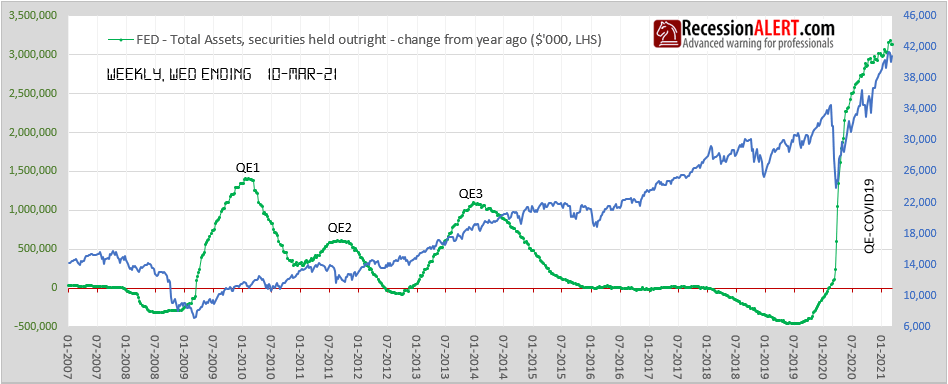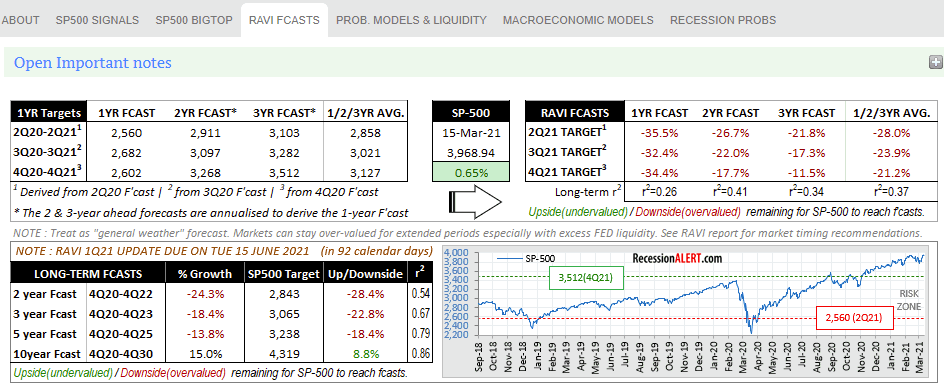In PART-1 we looked at how we used the RecessionALERT Valuation Index (RAVI) to determine 10-year ahead forecasts on the SP500 Total Return Index (TRI) with a better than 0.89 correlation, and how we managed to derive 5,3 and 2 year ahead SP500 forecasts with correlations of 0.8, 0.68 and 0.55 respectively.
In PART-2 we examined three methods to derive 1-year ahead forecasts for the Sp500 with correlations (r-squares) of 0.27, 0.34 and 0.43 respectively.
In PART-3 we use the data from PART-1 and PART-2 to measure the actual daily (real-time) risks we currently face as depicted by the 10, 5, 3, 2 and 1-year RAVI forecast models. This allows us to participate in the current massive liquidity-fueled rally, whilst being able to acknowledge, accept and understand our exact downside risk so that we can mitigate accordingly.
Note that the release of PART-3 was timed with the latest 4Q2020 RAVI publication to ensure latest data, and this means some figures seen here might differ slightly to those mentioned in PART-1 and PART-2
The everything-risk rally
The US Federal Reserve is undertaking a massive liquidity program (balance sheet expansion.) It is said that just under 25% of all dollars in existence were printed in 2020 alone. The general consensus over the decades is that Fed balance sheet expansion is positive for the stock markets as a lot of those dollars land up in risky assets such as stocks. As more recent times below show, whilst every SP500 rally doesn’t necessarily accompany balance sheet expansion, aggressive balance sheet expansion always provides strong tailwinds to the stock market:

With an additional $1.9 trillion in Biden-stimulus about to wash up on our shores, it would be a brave person indeed to take a negative view of the markets now. But it is not just the additional liquidity that lands up in the stock markets that provides the tailwinds. There are other considerations too.
Unprecedented quantitative easing/stimulus also drives inflation. Of course the stock market going up is also an inflation measurement but the entire commodities complex is undergoing a huge expansion. Iron ore, copper, oil, gold – you name it – its all going up. Even highly speculative inflation-hedge commodities such as Cryptocurrency (see our Bitcoin models) is ballooning. The housing market inflation in the US is also eye-watering. All this inflation has yet to wind its way into consumer pockets as secondary inflation, but its coming. And with inflation concerns come concerns about the purchasing power of the US dollar. When inflation and dollar strength concerns are high, investors rush to hard assets to protect themselves – stocks, property, crypto, gold – you name it.
So we have excess money looking to be parked somewhere to get a return, we have commodities, hard assets and speculative assets such as cryptocurrency ballooning and we have serious concerns about the ability of the US Dollar to retain its purchasing power. All of this is swamping any concerns about overtly high valuations (at least in our opinion).
If we are forced to partake in this inflation by participating in the stock market, we should at least try and acknowledge, accept and understand our exact downside risk so that we can mitigate accordingly.
INCREDIBLE OFFER : Get 50% discount off our annual PRO Subscription, PLUS order before 1 December and get a second year completely FREE. Get your discount HERE
Longer-Term risk
The latest RAVI data we have is from the 4th quarter 2020 RAVI release. The 2, 3, 5 and 10-year forecasts from this report appear below. It shows the forecasted growth of the SP500 Total Return Index (including dividends reinvested) from 4Q2020 (31 December 2020)

For the purposes of this exercise we will be conservative and apply these growth (or should we say decline) forecasts to the SP-500 index (excluding dividends reinvested) using the 31 December 2020 print of 3,756. This also provides us with target numbers we are more accustomed to following, namely the popular SP500 headline index itself:

With SP500 Targets now in hand, we can take the latest SP500 print of 3,968.94 from 15th March 2021 and calculate how far we are from the respective targets. These distances are shown in the “Up/Downside” column and are therefore direct measurements of our valuation risk over the given timeframes. The final column gives us the historical correlations of these forecasts over many decades and business cycles and therefore give an indication of the variance or accuracy we can expect across the different timeframes. Obviously the longer timeframes give the highest accuracy, but there is not that much difference between the 5 and 10-year forecast models.
We can therefore say that our risk between now and 4Q2022 (30 December 2022) equates to -28.4%. This is how much the market could conceivably correct by during this period to bring valuations back to “mean” or “fair” values. The more the SP500 continues to climb higher than 3,968.94, the higher this downside potential becomes, since the target of 2,843 remains fixed and we will be getting further and further away from it (above it). The lower the SP500 falls below 3,968.94 the lower this downside potential becomes since we will be getting closer to the target of 2,843. If we should encounter a correction greater than 28.4% from 15th Dec 2021, then the downside risk flips to an upside potential, since the SP500 will then be lower than the target of 2,843.
Similarly, our risk between now and 4Q2025 is much lower and equates to -18.4%. This is how much the market could conceivably correct by during this period to bring valuations back to “mean” or “fair” values. The more the SP500 continues to climb higher than 3,968.94, the higher this downside potential becomes, since the target of 3,238 remains fixed. The lower the SP500 falls below 3,968.94 the lower this downside potential becomes since we will be getting closer to the target of 3,238. If we should encounter a correction greater than 18.4% from 15th Dec 2021, then the downside risk flips to an upside potential, since the SP500 will then be lower than the target of 3,238.
Shorter-term risk
For this assessment, we will use the 1-year RAVI forecasts. If you recall in PART-2 we had four mechanisms to provide reasonably accurate one-year ahead SP500 forecasts:
- The straight one-year derived forecast (r-square = 0.26)
- The two year RAVI forecast, but annualized (r-square = 0.41)
- The three-year RAVI forecast, but annualized (r-square= 0.34)
- The average of (1),(2) and (3) (r-square = 0.37)
We can use all of these for various short-term forecasts that are 1 quarter, 2 quarter and 3quarters ahead from our current quarter.
To derive a forecast to the end of 2Q2021 (a 3-month forecast) for example, we can take the 2Q2020 RAVI assessments for each of (1) through (4) above to give four potential targets to end 2Q2021. We can do the same with the 3Q2020 RAVI assessment to give a forecast through to 3Q21, and also do the same with the latest 4Q2020 RAVI to give a forecast through to end 4Q2021. Again, the RAVI is providing forecasts for the SP500 Total Return Index but over these short time frames using the vanilla SP500 headline-index should be no problem. This provides us with three near-term SP500 targets from the 1YR forecast model, from the 2YR forecast model (annualized), from the 3YR forecast model (annualized) and the average of all 3:

So for 2Q2021 we have a forecast range of 2,560 through to 3,103. For 3Q2021 we have a forecast range of 2,682 to 3,282. For 4Q2020 we have a forecast range of 2,602 to 3,512.
With the short-term forecasts in hand, we can look at the SP500 index for today (15 March 2021) and calculate how much upside/downside (opportunity or risk) is still available to reach the target in question:

So for 2Q2021 we have a risk range of 21.8% through to 35.5%. For 3Q2021 we have a risk range of 17.3% to 32.4%. For 4Q2020 we have a risk range of 11.5% to 34.4%
For all of these short-term forecasts we can highlight the minimum risk (highest target or target closest to todays SP500 value ) and the maximum risk (lowest target or target farthest from todays SP500 value). We can call this the short-term RISK zone:

We can narrow this risk zone by just focusing on the minimum/maximums from the 2YR FCAST model, since this currently has the highest accuracy (r-square=0.41):

It is interesting that in both the examples above, the borders of the risk zones seem very close to major SP500 pivot points (technical support/resistance levels). One could potentially readjust the risk borders to align with these major levels to provide even higher likelyhood of accuracy.
Conclusion
With potential hard, short-term risk percentages now available we can figure out an appropriate hedging strategy or assess our risk reward. For example we could buy options that would cover us for a 35% loss. We could also make an assessment if the current liquidity/inflation/dollar-debasement environment is likely to propel the stock market higher than 35% or not. If we think the market could easily go up 70% from here, and we deem our maximum risk to be 35%, we can assume a 70/35= 2-to-1 reward/risk ratio.
All the tables and data shown in this note are updated daily and available in the CHARTS>DASHBOARD>RAVI FCAST tab:

INCREDIBLE OFFER : Get 50% discount off our annual PRO Subscription, PLUS order before 1 December and get a second year completely FREE. Get your discount HERE

Comments are closed.